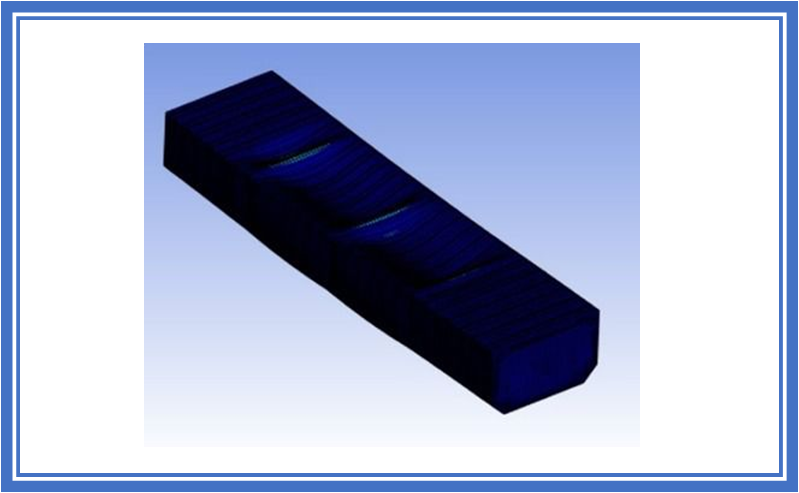Structural Strength Analysis of Car Deck Re-Layout Impact on Ro-Ro Ships Using Structural Analysis Method
DOI:
https://doi.org/10.21009/JKEM.10.1.7Keywords:
stress; deflection; ANSYS software; safety factor; BKI rulesAbstract
This study focuses on analyzing the structural strength of car deck construction in roll-on/roll-off (ro-ro) passenger ships. Ro-ro ships are designed to transport both vehicles and passengers, in which vehicles can drive in and out under their own power. While these ships are operational, there is a potential for improvement in their construction strength, particularly in the car deck area. The car deck is a critical structural component as it bears both vehicle loads and supports the upper decks. This research analyzes the car deck's structural integrity, which was initially designed for trucks and sport utility vehicles (SUV), under various conditions including calm water, sagging, and hogging scenarios. Using both finite element method (FEM) analysis through ANSYS software and manual calculations via Excel, the study evaluates maximum stress points and deflection. The 3D modeling was completed using Fusion 360, while 2D drawings were created in AutoCAD. Results revealed that the highest stress occurs during hogging conditions with truck loads, showing 188.23 MPa stress and 0.077128 m deflection. With a safety factor of 1.3281, these values comply with Indonesian Classification Bureau (BKI) standards, which require stress below 250 MPa and a safety factor above 1.
References
[1] K. Saddhono and Ermanto, “Indonesian online media’s construction of “maritime”: a critical discourse analysis,” Pomorstvo, vol. 34, no. 1, pp. 16–23, 2020, doi: 10.31217/p.34.1.2.
[2] A. Buonomano, G. Del Papa, G. Francesco Giuzio, R. Maka, and A. Palombo, “Advancing sustainability in the maritime sector: energy design and optimization of large ships through information modelling and dynamic simulation,” Appl. Therm. Eng., vol. 235, p. 121359, 2023, doi: 10.1016/j.applthermaleng.2023.121359.
[3] G. Xiao, Y. Wang, R. Wu, J. Li, and Z. Cai, “Sustainable maritime transport: a review of intelligent shipping technology and green port construction applications,” J. Mar. Sci. Eng., vol. 12, no. 10, p. 1728, 2024, doi: 10.3390/jmse12101728.
[4] A. F. Molland, “Marine vehicle types,” The Maritime Engineering Reference Book, Elsevier, 2008, pp. 43–74. doi: 10.1016/B978-0-7506-8987-8.00002-0.
[5] L. Li, “Research on roll-on and roll-off transportation of large-scale research on roll-on and roll-off transportation of large-scale equipment in dalian,” World Maritime University, 2020.
[6] D. J. Eyres and G. J. Bruce, “Basic design of the ship,” in Ship Construction, Elsevier, 2012, pp. 3–9. doi: 10.1016/B978-0-08-097239-8.00001-5.
[7] M. Gil, “A concept of critical safety area applicable for an obstacle-avoidance process for manned and autonomous ships,” Reliab. Eng. Syst. Saf., vol. 214, p. 107806, 2021, doi: 10.1016/j.ress.2021.107806.
[8] J. Jia and A. Ulfvarson, “Dynamic analysis of vehicle–deck interactions,” Ocean Eng., vol. 33, no. 13, pp. 1765–1795, 2006, doi: 10.1016/j.oceaneng.2005.10.012.
[9] A. Alamsyah, A. R. Falevi, A. I. Wulandari, M. U. Pawara, W. Setiawan, and A. M. N. Arifuddin, “Investigating the local stress of car deck ro-ro 5000 GT,” EPI-IJE, vol. 4, no. 1, pp. 57–62, 2021, doi: 10.25042/epi-ije.022021.08.
[10] D. J. Thomas, “Using finite element analysis to assess and prevent the failure of safety critical structures,” J. Fail. Anal. and Preven., vol. 17, no. 1, pp. 1–3, 2017, doi: 10.1007/s11668-016-0217-8.
[11] G. Michaloudis, G. Blankenhorn, S. Mattern, and K. Schweizerhof, “Modelling structural failure with finite element analysis of controlled demolition of buildings by explosives using LS-DYNA,” in High Performance Computing in Science and Engineering ’09, Berlin, Heidelberg: Springer Berlin Heidelberg, 2010, pp. 539–551. doi: 10.1007/978-3-642-04665-0_37.
[12] D. Doan, A. Szeleziński, L. Murawski, and A. Muc, “Finite element method in modeling of ship structures. Part II – practical analysis example,” Sci. J. Gdyn. Marit. Univ., no. 105, pp. 19–31, 2018, doi: 10.26408/105.02.
[13] A. Munjiza, T. Bangash, and N. W. M. John, “The combined finite–discrete element method for structural failure and collapse’, Eng. Fract. Mech., vol. 71, no. 4–6, pp. 469–483, 2004, doi: 10.1016/S0013-7944(03)00044-4.
[14] D. J. Thomas, “Using finite element analysis methods to reduce the failure of building structures,” J. Fail. Anal. and Preven., vol. 20, no. 3, pp. 615–616, 2020, doi: 10.1007/s11668-020-00900-2.
[15] J. Ren, Y. Chen, Z. Sun, and Y. Zhang, “A vehicle-bridge interaction vibration model considering bridge deck pavement,” J. low freq. noise vib. act. control, vol. 42, no. 1, pp. 146–172, 2023, doi: 10.1177/14613484221122736.
[16] A. Z. Tuswan, A. Budipriyanto, and S. H. Sujiatanti, “Comparative study on ferry ro-ro’s car deck structural strength by means of application of sandwich materials,” in Proceedings of the 3rd International Conference on Marine Technology, SCITEPRESS - Science and Technology Publications, 2018, pp. 87–96. doi: 10.5220/0008542800870096.
[17] A. Glykas, T. Lilas, I. Tsarouchas, and N. Nikitakos, “Stress and fatigue analysis of a floating desalination platform,” in Society of Naval Architects and Marine Engineers, 2008.
[18] J. Abedin, F. Franklin, and S. M. I. Mahmud, “Validation of the hull girder deflection of a multipurpose cargo ship,” ASEAN Eng. J., vol. 14, no. 2, pp. 183–193, 2024, doi: 10.11113/aej.V14.21054.
[19] A. Rachmianty, S. Baso, and S. Asri, “The influences of lengthening dimension of ro-ro ferry toward the considerations of hydrodynamics characteristic and loading capacity aspect,” EPI-IJE, vol. 2, no. 1, pp. 41–45, Jun. 2019, doi: 10.25042/epi-ije.022019.08.
[20] S. Bengtsson, K. Andersson, and E. Fridell, “A comparative life cycle assessment of marine fuels,” in Proceedings of the Institution of Mechanical Engineers, Part M: Journal of Engineering for the Maritime Environment, vol. 225, no. 2, pp. 97–110, 2011, doi: 10.1177/1475090211402136.
[21] Hasanudin, I. K. A. P. Utama, and J.-H. Chen, “Application side casing on open deck roro to improve ship stability,” in IOP Conf. Ser. Earth Environ. Sci., vol. 135, p. 012017, 2018, doi: 10.1088/1755-1315/135/1/012017.
[22] Hasanudin, A. Zubaydi, W. D. Aryawan, and I. K. A. P. Utama, “The effects of side-casings balance on open-deck-ro-ro vessels in term of intact stability,” in IOP Conf. Ser. Earth Environ. Sci., vol. 557, no. 1, p. 012052, 2020, doi: 10.1088/1755-1315/557/1/012052.
[23] Y. V. Satish Kumar and M. Mukhopadhyay, “Finite element analysis of ship structures using a new stiffened plate element,” Appl. Ocean Res., vol. 22, no. 6, pp. 361–374, Dec. 2000, doi: 10.1016/S0141-1187(00)00014-6.
[24] W. K. Liu, S. Li, and H. S. Park, “Eighty years of the finite element method: birth, evolution, and future,” Arch. Computat. Methods Eng., vol. 29, no. 6, pp. 4431–4453, 2022, doi: 10.1007/s11831-022-09740-9.
[25] A. Sivasankar and B. Ramanathan, “Design and numerical investigation of static and dynamic loading characters of heterogeneous model leaf spring,” Int. J. Mech. Eng. Res., vol. 5, no. 1, 2015.
[26] T. Wenzel, “Analysis of the relationship between vehicle weight/size and safety, and implications for federal fuel economy regulation,” in Office of Energy Efficiency and Renewable Energy, US Department of Energy, 2010.
[27] J. Jihanny, B. S. Subagio, and E. S. Hariyadi, “The analysis of overloaded trucks in indonesia based on weigh in motion data (east of sumatera national road case study),” in MATEC Web of Conferences, vol. 147, p. 02006, Jan. 2018, doi: 10.1051/matecconf/201814702006.
[28] A. Budiharjo, T. Andika, N. Fitriani, R. Rukman, and B. Turasno, “Operational data analytics of over dimensional and overloaded truck in indonesia,” in RSF Conference Series: Engineering and Technology, vol. 2, no. 2, pp. 88–98, 2022, doi: 10.31098/cset.v2i2.562.
[29] American Bureau of Shipping, “Rules and guides,” https://ww2.eagle.org/en/rules-and-resources/rules-and-guides-v2.html.
[30] F. M. Burdekin, “General principles of the use of safety factors in design and assessment,” Eng. Fail. Anal., vol. 14, no. 3, pp. 420–433, 2007, doi: 10.1016/j.engfailanal.2005.08.007.
[31] H.-C. Cho, S.-H. Lee, S.-H. Choi, S.-T. Yi, W.-H. Kang, and K. S. Kim, “Structural safety inspection of reinforced concrete structures considering failure probabilities of structural members,” Int. J. Concr. Struct. Mater., vol. 17, no. 1, p. 12, 2023, doi: 10.1186/s40069-022-00571-3.
[32] Biro Klasifikasi Indonesia, “(Vol B) Guidance for class notations,” https://www.bki.co.id/rule-0-1.html.
[33] M. U. Pawara, A. Alamsyah, R. J. Ikhwani, A. R. Siahaan, and A. M. N. Arifuddin, “A finite element analysis of structural strength of ferry ro-ro’s car deck,” INVOTEK: Jurnal Inovasi Vokasional dan Teknologi, vol. 22, no. 1, pp. 47–60, 2022, doi: 10.24036/invotek.v22i1.959.

Downloads
Published
How to Cite
Issue
Section
License
Copyright (c) 2025 Ferdie Hanafi Putra, Priyambodo Nur Ardi Nugroho, Boedi Herijono

This work is licensed under a Creative Commons Attribution 4.0 International License.





















